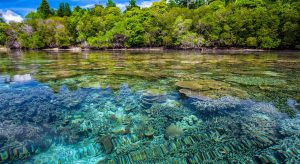
Dehradun, the capital of Uttarakhand in northern India, is recognized for its beautiful landscapes, enjoyable climate, and closeness to popular hill stations such as Mussoorie. Located in the Doon Valley, it is bordered by the Himalayas to the north, the Shivaliks to the south, and the Ganges and Yamuna rivers. Dehradun is recognized for its esteemed educational institutions, notably The Doon School and the Welham Schools, which have a history of notable alumni. It serves as a starting point for trekking in the Garhwal Himalayas, including the Nag Tibba trek. The city also provides adventure activities like paragliding and white-water rafting. Culinary highlights include traditional dishes such as Aloo ke Gutke and Kumaoni Raita, as well as sweets like Bal Mithai and Singodi. Dehradun boasts colonial-era architecture, signifying its historical significance. It is known for producing high-quality Basmati rice and delicious litchis, which are harvested in summer and exported widely. The local craftsmanship includes woolen garments, wooden artifacts, and Tibetan crafts due to the local Tibetan community. Dehradun celebrates a variety of traditional and modern festivals such as Diwali, Holi, and the local Kauthig, reflecting its diverse cultural heritage from Garhwali, Kumaoni, Sikh, and Tibetan communities. The city’s multicultural atmosphere is evident in its population, cuisine, and festivals. Additionally, Dehradun is emphasizing eco-tourism, aiming to balance development with the preservation of natural beauty through responsible travel and conservation efforts. Here is a look at the 2-day itinerary for the city of Dehradun.
Day 1- Explore the city’s heritage and culture: Start the morning by visiting the Forest Research Institute (FRI). FRI is a leading institute focused on forestry research, addressing key issues like conservation, biodiversity, climate change, and sustainable resource management. Its work is essential for protecting forests, vital for environmental balance and the economy. The campus features impressive Greco-Roman and Colonial architecture by C.G. Blomfield from 1929, covering over 450 hectares, making it one of the largest brick structures globally and a national heritage site. Its architectural beauty has made the campus a favored site for film shoots, further enhancing its reputation. After this, head to Robber’s Cave. Robber’s Cave is a 600-meter-long natural cave featuring a river that intermittently disappears and reappears, creating an intriguing phenomenon. Composed of limestone, the cave includes a waterfall and serves as a valuable site for studying river caves and karst landscapes. Its cool environment and beautiful stream make it a favored spot for picnics and short hikes. Visitors can enjoy the adventure of walking through the cave’s knee-deep water with sunlight streaming through narrow openings, attracting families, nature enthusiasts, and photographers. The cave’s name originates from local legends of robbers using it as a hideout, adding historical allure and interest for those fascinated by folklore. Then visit the Tapkeshwar Temple, a cave temple devoted to Lord Shiva, famous for water naturally dripping on the Shiva Lingam. In the evening, explore Paltan Bazaar for shopping and street food, including local snacks like chaat, bun aloo tikki, and momos.
Day 2- Nature and Adventure: Start your day at Mindrolling Monastery, one of India’s largest Buddhist centers, known for its beautiful architecture featuring intricate murals, statues, and stupas. The Great Stupa of the Buddha, standing at 185 feet, is one of the tallest in the world and symbolizes Buddhist cosmology. The monastery’s serene atmosphere, lovely gardens, and remarkable architecture provide a peaceful retreat for visitors interested in Buddhism and Tibetan culture. Next visit Malsi Deer Park, now called Dehradun Zoo, is a key recreational and educational location in Dehradun. Originally a sanctuary for deer, it now houses various species, including spotted and sambar deer, while providing a safe habitat. The park has developed into a small zoo, contributing to the conservation of several animal and bird species, including those that are endangered or vulnerable in the wild. Enjoy a meal at a café or restaurant on Rajpur Road, a well-loved dining area. In the afternoon, visit Sahastradhara, known for its sulphur springs and waterfalls, where you can bathe in the waters or take a ropeway ride. In the evening, explore Dehradun’s lively café scene by checking out popular spots such as Café De Piccolo, The Orchard, or Café Marigold.
-Triparna







